Homemade Golumpki Recipe (Golabki)
Published October 10, 2024. This post may contain affiliate links. Please read my disclosure policy.
This Homemade Golumpki Recipe is a Polish favorite. It consists of tender meat stuffing wrapped in cabbage leaves and cooked in a delicious broth and tomato sauce. I almost always double this recipe because my family loves it so much.
While golumpki are plentiful and usually eaten by themselves, some everyday side dishes are Roasted Potatoes or Bread and Butter.
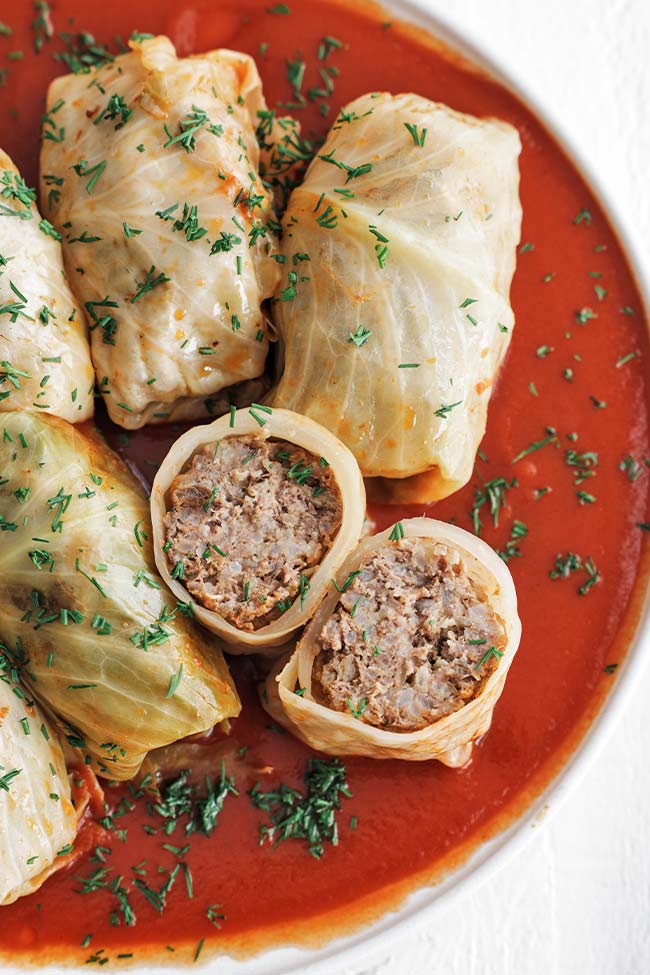
Golumpki
Golumpki is a Polish specialty of ground meat, usually pork, veal, or beef, mixed with barley or rice and stuffed and rolled inside pre-cooked cabbage leaves. Once rolled, they can be braised or baked in broth or pan-seared in a small amount of butter. They are commonly served with a simple tomato sauce or even a creamy mushroom sauce. Both are delicious and work well for this.
The different types of spices, herbs, and ingredients added to the stuffing before wrapping can also vary.
Golumpki History
While golumpki, also known as golabki, are considered native of Poland, they have deeper roots in central and Eastern European countries. With cabbage being a staple in these countries, it’s likely derived from the Ukrainian dish holbuci.
This was an elegant recipe for a dove stuffed with other foods and wrapped in cabbage leaves. Golumpki in Poland not only refers to the dish but also to “dove.” However, once the dish spread to the poorer peasant classes, it was most likely adapted to include minced meat, the recipe we know today.
Looking even further back at the earliest versions of golabki, due to its affordability and accessibility, it would have been stuffed with buckwheat and potatoes. If you’re interested in more traditional Polish food, try my Pierogi Recipe.
Ingredients and Substitutions
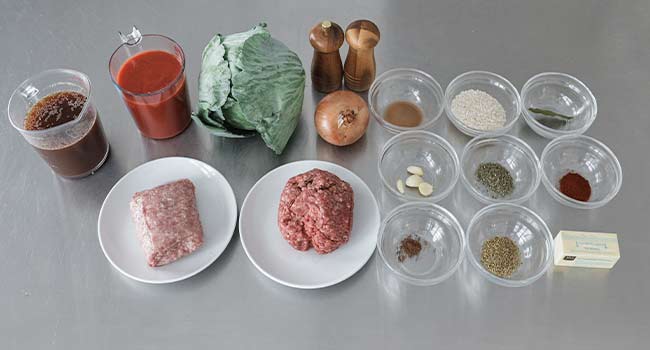
- Beef – You can use 80/20, 85/15, 90/10, or 94/6 ground beef from any meat cut.
- Pork – Ground pork or minced ham is the most common. However, you can use all beef or all pork in the stuffing.
- Cabbage — Younger cabbage with greener leaves that are not tightly held to the head of the cabbage is best. However, a more mature cabbage or even savoy cabbage will also work.
- Tomatoes — You will need Canned tomato puree or whole or canned tomatoes blended until smooth. In addition, tomato paste is used.
- Stock – Beef stock is best to use when braising the golumpki. However, chicken stock, brodo, or water will work.
- Onion – White, yellow, or sweet onion can be used. In addition, whole garlic cloves are used in the stuffing.
- Spices – I used regular paprika in the stuffing and ground allspice in the tomato sauce. Both of these are optional.
- Herbs – I added dried oregano and marjoram to the stuffing and used a bay leaf in the sauce.
- Grains — Pearl barley is classic, but long-grain rice is the more modern ingredient to mix with the stuffing.
- Butter – I always use unsalted butter in my cooking and baking to control the sodium content.
- Bread — Any bread is suitable, including plain white or artisan bread. This is my secret ingredient for ensuring the stuffing is incredibly tender and moist.
How to Make Golumpki from Scratch
Add the rice to a small saucepot and cook, constantly stirring, over low heat.
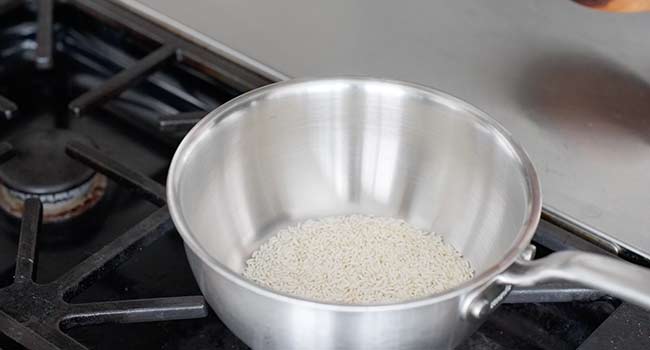
Pour in the water, gently season with salt, stir, add on a lid, and cook for only 8 minutes.
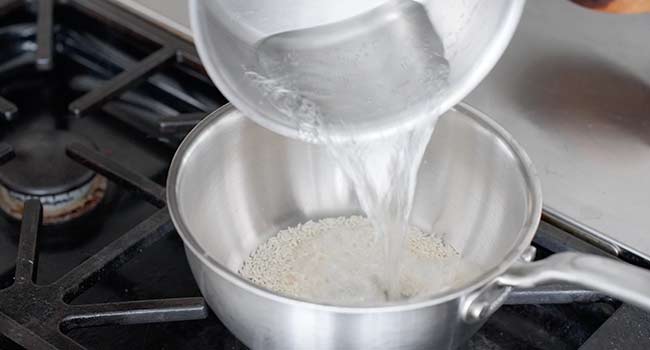
Set the rice to the side to completely cool.
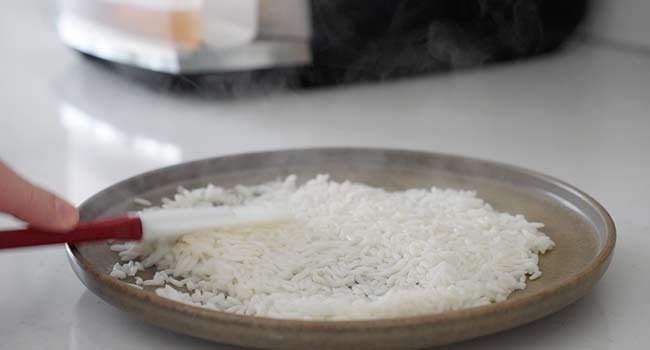
Next, melt the butter in a large frying pan over medium heat until it’s melted. Add the onions, gently season with salt, and sauté for 5 minutes or until lightly browned.
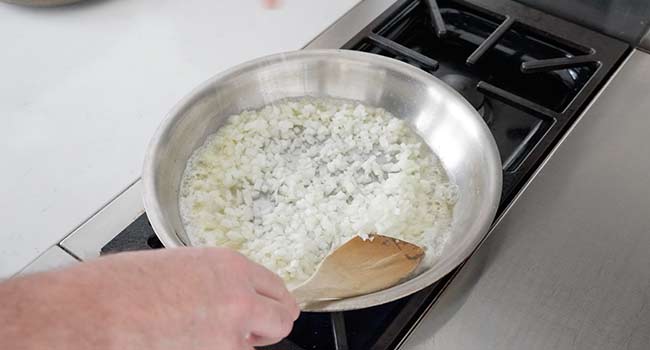
Turn the heat down to low and stir occasionally for 10 minutes.
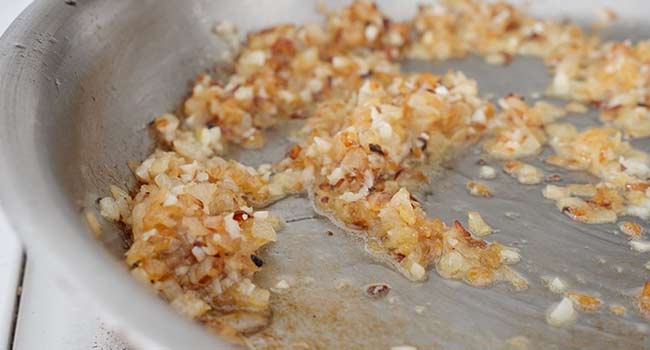
Mix in the bread until it is coated in the butter and onions and softened. Set aside to cool, which takes about 10 minutes.
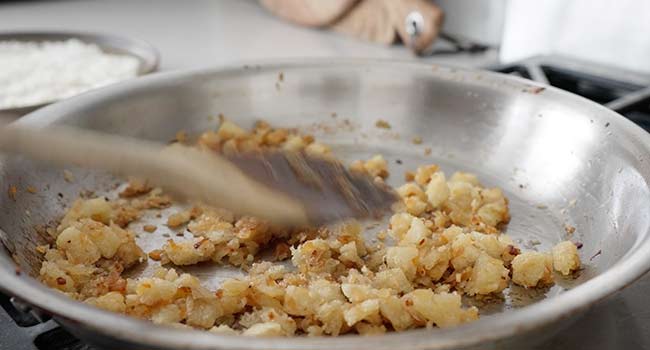
Once the rice, bread, onions, and garlic are cooled, add them to a large bowl with beef, pork, marjoram, oregano, paprika, salt, and pepper. Set it to the side.

Carefully remove the cabbage’s core.
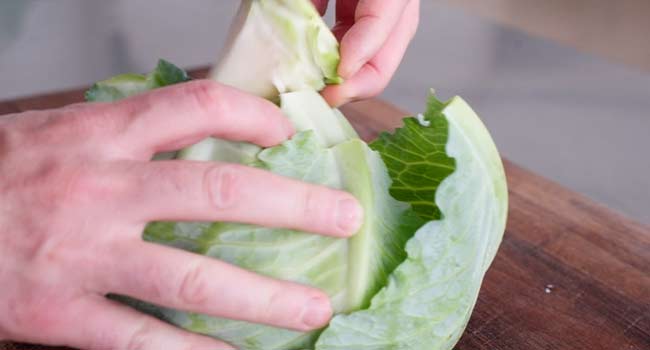
Add the cored cabbage head to a large pot of boiling salted water and cook for 3 to 4 minutes per side.
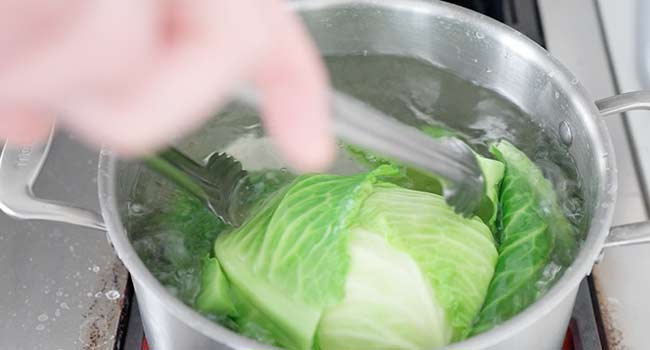
Carefully remove the leaves, making sure not to tear them. You should get 16-18 leaves.
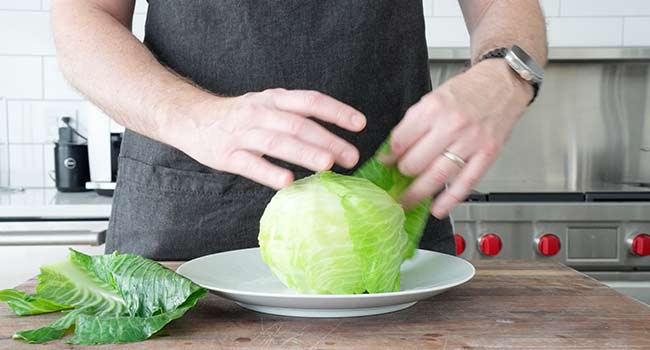
Flatten each cabbage leaf out and trim the main thick vein.
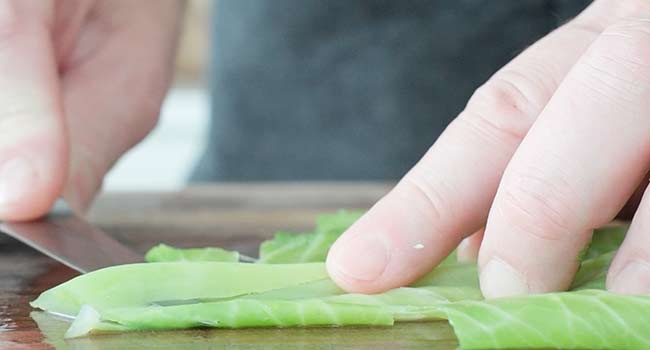
Place some meat in the lower third section of the cabbage leaf, fold in the sides, and roll it up.
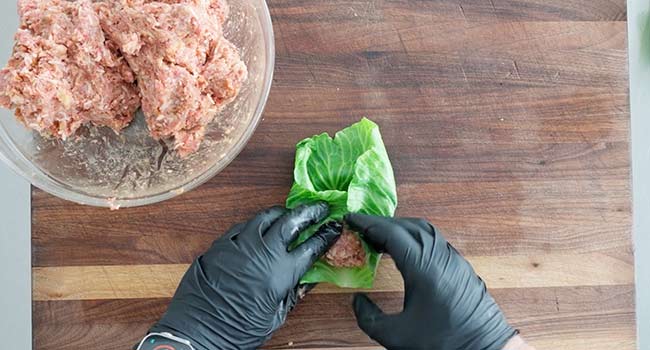
Cut the remaining cabbage heart into wedges.
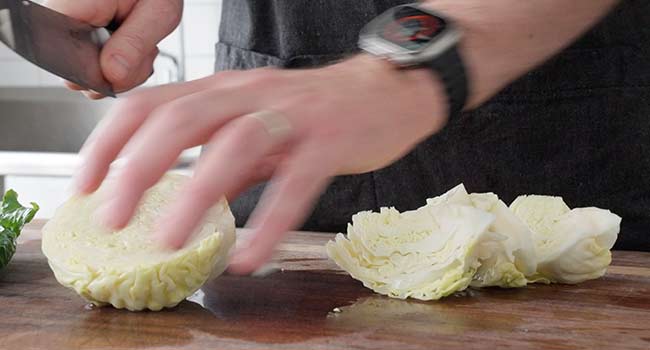
Place the wedges, the core, and any loose leaves not used in the bottom of a deep pot. Layer on all the golumpki until all are in the pot.
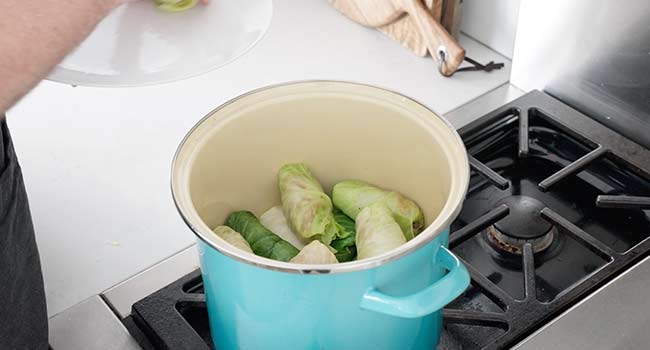
Stir the tomato paste into the beef stock and pour it into the pot.
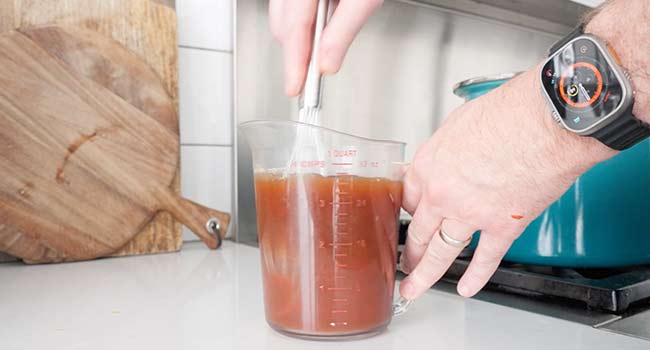
Bring the mixture to a boil over high heat, then add on a lid and simmer over low heat for 50 to 60 minutes or until the cabbage leaves are tender and the stuffing is cooked.
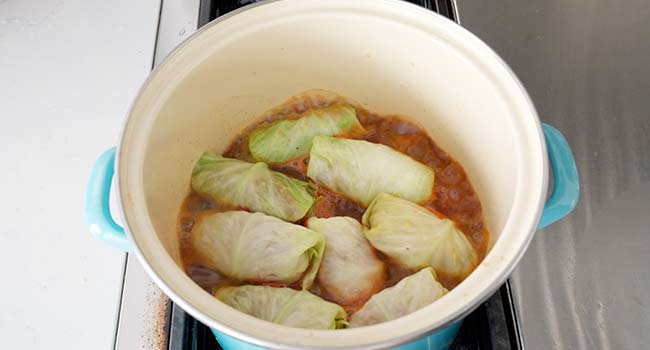
For the Sauce
Drain the braising liquid from the golabki into a separate pot.
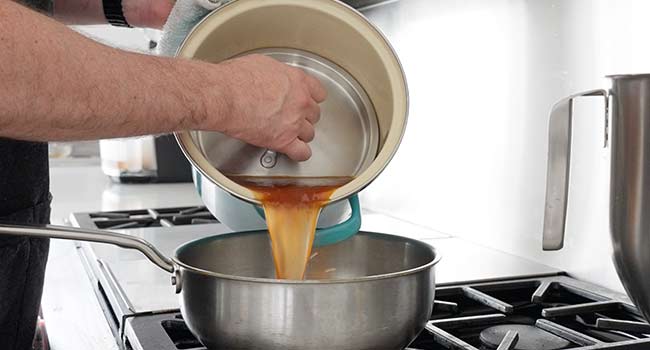
Pour in the tomato puree, bay leaf, allspice, and salt. Heat over medium-high heat while frequently stirring until it is reduced by 25%, which takes about 15 minutes. This will help concentrate the flavors.
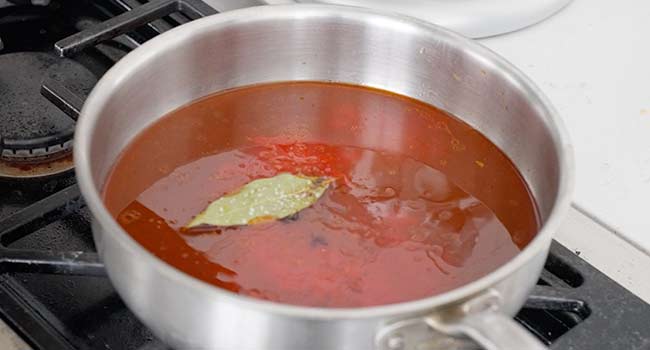
Finish the sauce with butter, vinegar, salt and pepper.
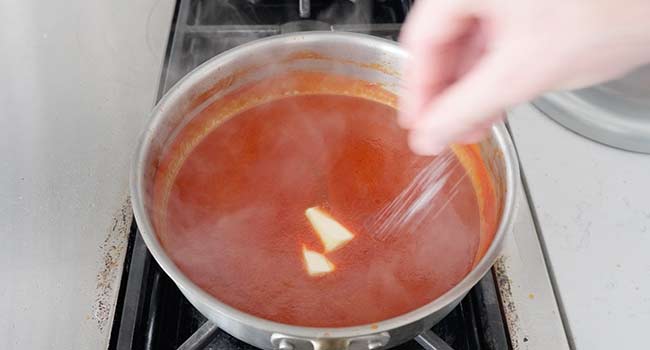
Serve the sauce with the golabki.
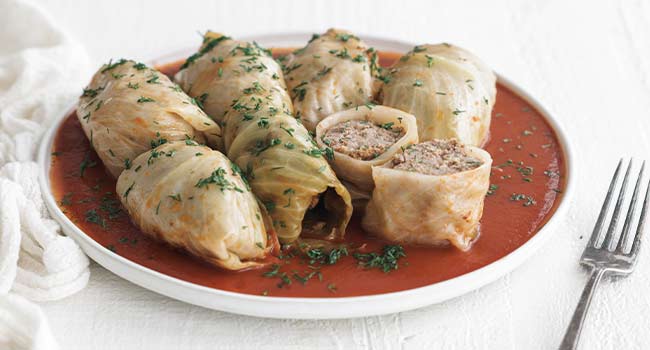
Make-Ahead and Storage
Make-Ahead: For freshness, these are best eaten right away. However, you can cook, cool, and make them two days ahead. You can also stuff and wrap them without cooking up to one day ahead.
How to Store: Cover and store in the fridge for up to 4 days. Freeze the golumpki for up to 3 months. It’s best to store the golabki separately from the tomato sauce. Thaw in the refrigerator for one day before reheating.
How to Reheat: Add the desired number of golumpki into a baking dish along with some of the tomato sauce. Cover and bake in the oven at 350° for 20 to 25 minutes or until hot.

Chef Notes + Tips
- You want the rice to be slightly undercooked because it will continue cooking when braised in the cabbage stuffing.
- If using barley, you’ll need ¼ cup barley and ¾ cup water to make the stuffing. Check out my How to Cook Barley procedures. It’s best to slightly undercook the barley, as it will continue to cook after being stuffed in the golabki.
- I advise frying a small piece of the stuffing batter in a little oil to ensure its deliciousness so you can adjust the seasonings accordingly.
- The boiling water for the cabbage must be salted to season the leaves.
- If you notice that pulling away the cabbage leaves from the head becomes more complicated, add the cabbage to the boiling water for 2 to 3 more minutes per side.
- The outside leaves can be tougher, but they are still edible.
- You add the leftover cabbage to the bottom of the pot so that the golumpki does not stick to the pot.
- I usually add a half cup of water to the tomato container and swoosh it around to remove all the tomatoes before adding them to the sauce.
- Cover the golabki in the pot while the tomato sauce is cooking. They will stay warm for up to 45 minutes.
More Main Course Recipes

Video
Homemade Golumpki Recipe (Golabki)
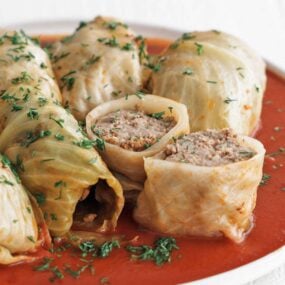
Ingredients
For the Golabki:
- 1/3 cup long grain rice
- 2/3 cup water
- 5 tablespoons unsalted butter
- 1 peeled and small diced medium sized yellow onion
- 4 finely minced garlic cloves
- 2 slices of large diced bread, crusts removed
- 1 pound 85/15 ground beef
- 1 pound ground pork
- 1 ½ teaspoons marjoram
- 1 ½ teaspoons oregano
- ½ teaspoon paprika
- 1 young head of green cabbage
- 4 cups beef stock
- 2 tablespoons tomato paste
- coarse salt and fresh cracked pepper to taste
For the Sauce:
- 28 ounces tomato puree
- 1 bay leaf
- 1/16 teaspoon ground all-spice
- 2 tablespoons unsalted butter
- 1 teaspoon red wine vinegar
- coarse salt and freshly cracked pepper
Instructions
- Add the rice to a small saucepot and cook while constantly stirring over low heat for 3 to 4 minutes or until it becomes milky white. Pour in the water, gently season with salt, stir, add on a lid, and cook for only 8 minutes. Set the rice to the side to completely cool.
- Next, melt the butter in a large frying pan over medium heat. Add onions, gently season with salt, and sauté for 5 minutes or until lightly browned.
- Turn the heat down to low and stir occasionally for 10 minutes or until caramelized before mixing in the garlic. Cook until it becomes fragrant, which only takes 30 to 45 seconds.
- Mix in the bread until it is coated in the butter and onions and softened. Set aside to cool, which takes about 10 minutes.
- Once the rice, bread, onions, and garlic are cooled, add them to a large bowl along with the beef, pork, marjoram, oregano, paprika, salt, and pepper, and mix to combine. Set it to the side.
- Carefully remove the core of the cabbage, keeping any loose leaves, and even the core. Add the cored cabbage head to a large pot of boiling salted water and cook for 3 to 4 minutes per side.
- Let the cabbage sit for 5 to 6 minutes or until you can touch it before carefully removing the leaves, making sure not to tear them. You should get 16-18 leaves. Flatten each cabbage leaf out and trim the main thick vein so that it can roll up.
- Take about 2 to 4 ounces of meat, place it in the lower third section of the cabbage leaf, fold in the sides, and roll it up. Repeat the process until all the meat is used.
- Cut the remaining cabbage heart into wedges. Place those wedges into the bottom of a deep pot along with the core and any loose leaves that were not used. Layer on all the golumpki until all are in the pot.
- Stir the tomato paste into the beef stock and pour it in the pot. Bring the mixture to a boil over high heat, then add on a lid and simmer over low heat for 50 to 60 minutes or until the cabbage leaves are tender and the stuffing is cooked.
- Drain the braising liquid from the golabki into a sperate pot.
- Pour in the tomato puree, along with bay leaf, all-spice, and salt. Heat over medium high heat while frequently stirring until it is reduced by 25%, which takes about 15 minutes. This will help concentrate the flavors.
- Finish the sauce with butter, vinegar, salt and pepper. Serve the sauce with the golabki.





Really liked this dish. Second time I’ve made it. Not too sweet.
What’s the reason it isn’t baked in the oven rather than simmered on the stovetop?
I used your beef stock recipe—very savory.
Thank you. I’ll make again for sure.
You can and I provide details in the post as well as in the video.
Extremely good! Loved this! Thanks
My pleasure.
Yesterday I made your Polish Cabbage Rolls. I followed your recipe to the tee. I have to say it was divine. I called them little bundles of joy and deliciousness. My husband does not like cabbage rolls but he loved these.
Your recipes keep me from going out to dinner because I can cook way better at home. I know the quality of the meat and vegetables that We are eating. I can control the salt and fat amounts. Let’s just say, I am a home cooking cheerleader of yours.
So glad you’re enjoying the recipes!
Bin making these for years,I tweaked my recipe more to yours delicious. Also I’ll use just good ham stock and bake it in that delicious
Turned out great though my cook times on the different steps takes me longer. I needed a bit more vinegar for my sauce which was very good. I learned a lot using the various techniques taught in this recipe. I would not say I nailed it but I enjoyed my dinner. Thank you for sharing this.
My pleasure.